The world’s eye was on the Philippines after it successfully
toppled down almost a decade of dictatorship rule through a peaceful demonstration tagged as
the EDSA People’s Power Revolution.
After the widowed wife of former Senator Benigno
"Ninoy" Aquino, Sr. was elected into office,
President Corazon
Cojuangco-Aquino faced both economic and political problems of the country.
Her rule as president began on February 25, 1986 after taking oath at the
Club Filipino in San Juan, Metro Manila. She was the 11th president of the
Philippines and the first woman to become president of the country.
She was tasked to put together a nation devastated by the rule of her predecessor
Ferdinand E. Marcos. It
was not an easy task since the country’s economic condition was in its worse state since 1982.
Filipinos living below the poverty line is alarmingly increasing in number. Aquino also
struggled with Marcos’ supporters in the Armed Forces of the Philippines who
attempted to remove her from power. The group of soldiers, who called themselves
members of the ‘Reform the Armed Forces Movement’ or RAM, staged seven coup
attempts against the Aquino administration. The attack held in August 28, 1987,
which killed at least 53 people and injured more than 200 others, was the most
serious attack the government experienced. These attacks worsened the economic
condition of the Philippines as investors became wary about Aquino’s ability to
rebuild the country. The International Monetary Fund (IMF), the
World Bank and the United States also
forced the government to fulfill its obligations to pay an estimated $27.2 billion worth of debt
Aquino inherited from the previous administration. To be eligible for IMF’s rehabilitation programs,
Aquino instigated reforms towards a freer economy. These reforms ended monopolization
of the agricultural industry of the country, reduced tariffs and lifted import
controls in the Philippines.
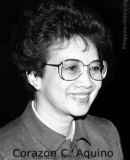 The political condition of the country at that time did not look any better. To
resolve the issue, Aquino commissioned a referendum that would be the framework
for the new government. It tackled various issues from shifting the government
from presidential to parliamentary, to economic reforms involving foreign
participations. Due to its immediate necessity, details of the referendum were
left to the legislature to determine. Released in February 1987, the new charter
easily won the approval of the public.
The political condition of the country at that time did not look any better. To
resolve the issue, Aquino commissioned a referendum that would be the framework
for the new government. It tackled various issues from shifting the government
from presidential to parliamentary, to economic reforms involving foreign
participations. Due to its immediate necessity, details of the referendum were
left to the legislature to determine. Released in February 1987, the new charter
easily won the approval of the public.
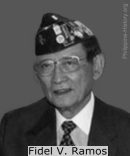 The rule that followed Aquino’s presidency established steadier governance of
the Philippines. Fidel V. Ramos took
office in 1992 and immediately worked on the country’s recovery. Ramos initiated the
Social Reform Agenda or SRA that was geared towards alleviating poverty.
The Gross
National Product reached an average of 5 percent annually, which translated to a
growth in the average family income of the Filipinos. He undertook the implementation of
Build-Operate-Transfer (BOT) law which improved public infrastructure and
deregulated several industries to help liberalize the economy. The country also
saw improvements in its relations to secessionist Moro Islamic
Liberation Front
or MNLF as Ramos achieved a peace agreement with the group. Ramos bagged the
first UNESCO Peace Award yet given to an
Asian for this effort. He also came to be known as the ‘Centennial’ President
for his successful supervision of the 100th anniversary of the country’s independence from the
Spanish rule celebrated
in June 12, 1998.
The rule that followed Aquino’s presidency established steadier governance of
the Philippines. Fidel V. Ramos took
office in 1992 and immediately worked on the country’s recovery. Ramos initiated the
Social Reform Agenda or SRA that was geared towards alleviating poverty.
The Gross
National Product reached an average of 5 percent annually, which translated to a
growth in the average family income of the Filipinos. He undertook the implementation of
Build-Operate-Transfer (BOT) law which improved public infrastructure and
deregulated several industries to help liberalize the economy. The country also
saw improvements in its relations to secessionist Moro Islamic
Liberation Front
or MNLF as Ramos achieved a peace agreement with the group. Ramos bagged the
first UNESCO Peace Award yet given to an
Asian for this effort. He also came to be known as the ‘Centennial’ President
for his successful supervision of the 100th anniversary of the country’s independence from the
Spanish rule celebrated
in June 12, 1998.
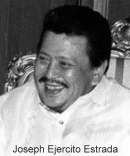 A
film actor, Joseph Ejercito Estrada, succeeded
Ramos as president in 1998. He was the previous mayor in the municipality of San Juan, Metro Manila
and vice president of Ramos, Estrada was placed into office by a wide margin of vote. He
gained support in the election for his promise to begin a pro-poor
administration that his predecessors failed to promote in their respective
platforms. This support dwindled down as his administration was rattled by
corruption. Critics accused him of failing to live up to his promises due to the
resurfacing of cronyism in the government. Efforts made by Ramos to resolve
political conflicts in Mindanao were also threatened as Estrada launched an
all-out war against the Islamic group in Mindanao called the Moro Islamic
Liberation Front in March 21, 2000. In the same year, Ilocos Sur Governor Luis
“Chavit” Singson accused Estrada of receiving Php 400 million from him as payoff
from illegal gambling profits. The revelation led to Estrada’s impeachment in
November 12, 2000 and his ouster from presidency in January 20, 2001. Then
Supreme Court Chief Justice Hilario
Davide, Jr. swore-in vice-president,
Gloria Macapagal-Arroyo as president the same day.
A
film actor, Joseph Ejercito Estrada, succeeded
Ramos as president in 1998. He was the previous mayor in the municipality of San Juan, Metro Manila
and vice president of Ramos, Estrada was placed into office by a wide margin of vote. He
gained support in the election for his promise to begin a pro-poor
administration that his predecessors failed to promote in their respective
platforms. This support dwindled down as his administration was rattled by
corruption. Critics accused him of failing to live up to his promises due to the
resurfacing of cronyism in the government. Efforts made by Ramos to resolve
political conflicts in Mindanao were also threatened as Estrada launched an
all-out war against the Islamic group in Mindanao called the Moro Islamic
Liberation Front in March 21, 2000. In the same year, Ilocos Sur Governor Luis
“Chavit” Singson accused Estrada of receiving Php 400 million from him as payoff
from illegal gambling profits. The revelation led to Estrada’s impeachment in
November 12, 2000 and his ouster from presidency in January 20, 2001. Then
Supreme Court Chief Justice Hilario
Davide, Jr. swore-in vice-president,
Gloria Macapagal-Arroyo as president the same day.
The Philippine
Constitution allows the president to ran for a second term if
he/she was sworn into office by succession and served in less than 4 years,
otherwise the president is limited to one term of office.
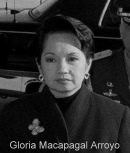 Arroyo
was qualified to ran for another term. Indeed, she did. In the 2004
Philippine General Election, Arroyo declared her presidential candidacy and she
was seated into office for the second time. Arroyo promoted a “Stronger
Republic” under her rule, which was geared toward vigorous economic reforms.
However, her administration was bombarded with several controversies and
impeachment attempts in the last five years. Hence, as she announced her
disinterest to extend her term or run for office in the 2010 elections, critics
expressed their apprehensions. Once, Arroyo had broken the people’s trust when
she declared that she was not interested to run in the 2004 elections.
Protesters express their disappointment every so often rallying at the streets
calling against the Charter Change (Cha-Cha) and now the Constituent Assembly
(Con-Ass), which is currently promoted by the Arroyo’s supporters in Congress
when the Cha-Cha attempt has become improbable receiving critical disapproval.
The representatives in the lower house of Congress were
said to have made the move independently to pass the Con-Ass however, many are skeptic
of the true agenda of the Arroyo administration as the 2010 election countdown nears.
Supporters of Arroyo are pushing for a change of government from a Presidential
to a Parliamentary form. This will enable Arroyo run for parliament and
become prime minister.
Arroyo
was qualified to ran for another term. Indeed, she did. In the 2004
Philippine General Election, Arroyo declared her presidential candidacy and she
was seated into office for the second time. Arroyo promoted a “Stronger
Republic” under her rule, which was geared toward vigorous economic reforms.
However, her administration was bombarded with several controversies and
impeachment attempts in the last five years. Hence, as she announced her
disinterest to extend her term or run for office in the 2010 elections, critics
expressed their apprehensions. Once, Arroyo had broken the people’s trust when
she declared that she was not interested to run in the 2004 elections.
Protesters express their disappointment every so often rallying at the streets
calling against the Charter Change (Cha-Cha) and now the Constituent Assembly
(Con-Ass), which is currently promoted by the Arroyo’s supporters in Congress
when the Cha-Cha attempt has become improbable receiving critical disapproval.
The representatives in the lower house of Congress were
said to have made the move independently to pass the Con-Ass however, many are skeptic
of the true agenda of the Arroyo administration as the 2010 election countdown nears.
Supporters of Arroyo are pushing for a change of government from a Presidential
to a Parliamentary form. This will enable Arroyo run for parliament and
become prime minister.
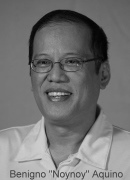 On the May 10, 2010 general
elections, Arroyo run and won for congresswoman for the 2nd district of
Pampanga province. Making her the first president to hold a lower office
after occupying the highest office of the land. On her first day as
congresswoman, Arroyo filed a resolution calling for Congress to hold a
Constitutional Convention to amend the constitution.
On the May 10, 2010 general
elections, Arroyo run and won for congresswoman for the 2nd district of
Pampanga province. Making her the first president to hold a lower office
after occupying the highest office of the land. On her first day as
congresswoman, Arroyo filed a resolution calling for Congress to hold a
Constitutional Convention to amend the constitution.
On June 30, 2010, Benigno Simeon Cojuangco Aquino
III, a.k.a Noynoy and PNoy, was proclaimed as the 15th president of the republic
together with Jejomar Cabauatan Binay as vice-president. Aquino is the
eldest son of former president Corazon Aquino and the assassinated
former senator Benigno Aquino, Jr. Aquino's 6-year term is marked by
both positive and negative events. He has been
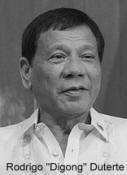 criticized
with his government's slow response to aid victims of Typhoon Haiyan,
the Mamasapano massacre and other crisis. In spite of these criticisms,
Aquino left the presidency with a with a stable democracy, higher credit
rating, surplus government funds and a Central Bank abundant in foreign
reserves. And unlike his predecessor, he was never directly accused of
corruption. In contrast, former Vice-President Jejomar Binay, who run
and lost the 2016 presidential elections, is implicated in several
anomalous government contracts.
criticized
with his government's slow response to aid victims of Typhoon Haiyan,
the Mamasapano massacre and other crisis. In spite of these criticisms,
Aquino left the presidency with a with a stable democracy, higher credit
rating, surplus government funds and a Central Bank abundant in foreign
reserves. And unlike his predecessor, he was never directly accused of
corruption. In contrast, former Vice-President Jejomar Binay, who run
and lost the 2016 presidential elections, is implicated in several
anomalous government contracts.
At 12 noon, June 30, 2016, Rodrigo "Digong" Roa Duterte (a.k.a.
Rody) takes oath as the 16th president of the Philippines at Malacanang Palace in Manila.
Duterte is a lawyer and politician, he is the former mayor and former 1st district
congressman of Davao City in Mindanao -an island in the southern Philippines
where Muslim insurgents are based. He is the first president to come from
Mindanao. He is clamoring for a change in the constitution from a presidential
to a federal form of government. Duterte won
the presidential elections as an outspoken, strong-willed crime fighter with an anti-establishment
stance. He is however criticized for his alleged support of vigilante groups involved in extra-judicial killings to fight crime.
Former congresswoman Maria Leonor "Leni" Santo Tomas Gerona-Robredo,
who won the vice-presidential elections took oath on the same day (June 30, 2016)
as Duterte but not at Malacanang Palace, but at a rented property in Quezon
City, Metro Manila. It is beacuse of Duterte's preference to have a separate oath taking. Robredo and Duterte are
non-aligned. Robredo belongs to the Liberal party while Duterte belongs to
PDP-Laban party. Robredo has declared her support and willingness to work with
Duterte's government from the time of her proclamation as winner of the VP race. Duterte however is sympathetic to defeated
vice-presidential candidate Ferdinand "Bongbong" Marcos, Jr., the son of former
dictator Ferdinand Marcos.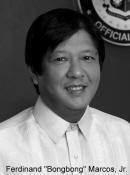
On May 9, 2022 elections, Ferdinand
Romualdez Marcos, Jr. run for President together with Sara Zimmerman Duterte-Carpio,
the daughter of President Duterte as vice-president. Marcos Jr., & Sara Duterte
won by a large margin. Incumbent vice-president Leonor "Leni"
Robredo, who ran for president against Marcos, Jr. lost in the hotly contested
race. So did Robredo's running mate senator Francis Pangilinan as
vice-president. Marcos, Jr. and Sara Duterte was sworn-in as president &
vice-president on June 30, 2022.